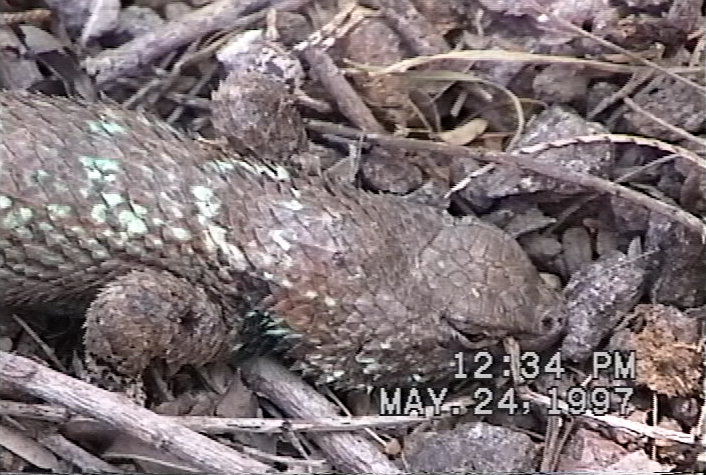Spiny Lizards (Sceloporus spp)
Main sources: Stebbins, Robert, 2003, A Field Guide to Western Reptiles and Amphibians, Houghton Mifflin; Behler, John & Wayne King, 1979, The Audubon Society Field Guide to North American Reptiles and Amphibians, NY: Alfred Knopf; Brennan, Thomas & Andrew Holycross, 2006, A Field Guide to Amphibians and Reptiles in Arizona, Phoenix: AZ Game & Fish Dept.
At least 8 species of Spiny Lizards are present in Arizona, but so far in our area we have only encountered two: Clark's Spiny Lizard and the Desert Spiny Lizard. Both these species have a coloring of dark wedges on the shoulder.
Desert Spiny Lizard (Sceloporus magister)
We photographed this Desert Spiny on May 2, 2008, on the second terrace above Lower Hot Springs Canyon. Though partially shadowed beneath an overhanging board, the details are diagnostic. In this full-grown animal the shoulder wedge extends in lighter shade all around the back. The dark coloring along the back behind the neck has a slightly purple tinge. Click on each image to enlarge it.
 ..
..
The Desert Spinys we see in Tucson are considerably lighter in dorsal color than the strong yellow-to reddish tones visible here. They have a more grayish cast, which makes the blue patches on belly and throat of the males stand out strongly (in any case these are not visible in the Hot Springs Canyon animal photographed here).
While we remain uncertain about the identity of this lizard below, we suspect it may be an immature Desert Spiny. We saw it on the same day and near the adult pictured above. It was very much smaller, and, as you can see, quite slender. It may have a tiny mite on the left side of its nose. Click on the image for a higher-resolution enlargement.

We saw this Spiny Lizard below from across an arm of Teran wash in July 2005, and used 7X zoom to capture it. (Click on each of the images below to enlarge it.) Here we were initially unsure of identification, since the Clark's Spiny (see further below) shares with the Desert the "conspicuous black wedge on the shoulder" (Stebbins 2003, plate 31), and this lizard is definitely "irregularly crossbanded with dark and light markings" (Op.cit., p. 287). However, the overall color pattern looks like Cascabel's Desert Spiny.
 .
. .
.
Clark's Spiny Lizard (Sceloporus clarkii)
We came upon these two Lizards below along the then dense-thicket trail along Sierra Blanca Spring in May of 1997, bearing at the time only a then-ok-quality videocamera. They were fat, and had perhaps been mating, as one of us stepped right over the pair without seeing them. Then the person following saw them (photo on the left), both appearing to be dead. However, they were visibly breathing, clearly playing dead to deceive us. So we got reasonably good images of them with the video camera, then prodded each one gently and they were off in a flash. From the poor imagery, we're unsure what species this is, but the overall grayish cast contrasts with the Desert Spiny.

The closer view below shows that the dark shoulder wedge in this animal does not extend around the neck, rather the scales behind the back of the neck are quite pale in color. Compare Stebbins 2003, Pl. 31, which shows a pale strip of scales on this location for the Clark's.

The other lizard, below, shows scale coloring that definitely does not conform to a Desert Spiny Lizard form. But neither of these show black bars on the forelimbs, which are expectable on the Clark's, though these images are far from sufficiently detailed to state their definite absence.

This lizard, below, quite dark overall, was clinging to a tree in Sierra Blanca Spring Wash, directly below a dove sitting on its nest. The lighting was poor (and the old videocamera as well), so the images are not very good, but note (as apparently also above-middle) the almost mica-like, shiny-whitish scales above the arm, and on the right below, the bicolored leg and pale-colored tail. It also has dark arm and leg bars, suggesting it is a Clark's. Click on each of the images below to enlarge it.
 ..
..
Return to Lizards